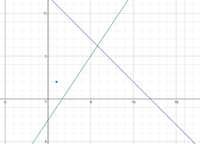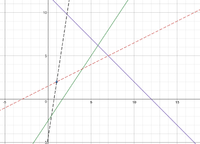Hi All
First post. It's an old question from the textbook I originally used in 1980's when studying A Level maths.
For the sheer fun of it I started to study maths again.
The question is:
A line is drawn though point A(1,2) to cut the line 2y=3x-5 at P and the line x+y =12 at Q.
If AQ=2AP, find the coordinates of P and Q.
I've tried approaches using distance between points, ratio of divided line formula, finding gradient of line PQ all to no avail. I have equations with four coordinates to be found and I can't seem to eliminate them via simultaneous equations. The question is in the original Bostock and Chandler book, Pure Mathematics 1 Chapter 4. The preceding chapter covered the basics, length of line, gradient, ratio of divided line etc, nothing very advanced.
Thanks for any advice, suggestions or solutions.
First post. It's an old question from the textbook I originally used in 1980's when studying A Level maths.
For the sheer fun of it I started to study maths again.
The question is:
A line is drawn though point A(1,2) to cut the line 2y=3x-5 at P and the line x+y =12 at Q.
If AQ=2AP, find the coordinates of P and Q.
I've tried approaches using distance between points, ratio of divided line formula, finding gradient of line PQ all to no avail. I have equations with four coordinates to be found and I can't seem to eliminate them via simultaneous equations. The question is in the original Bostock and Chandler book, Pure Mathematics 1 Chapter 4. The preceding chapter covered the basics, length of line, gradient, ratio of divided line etc, nothing very advanced.
Thanks for any advice, suggestions or solutions.


